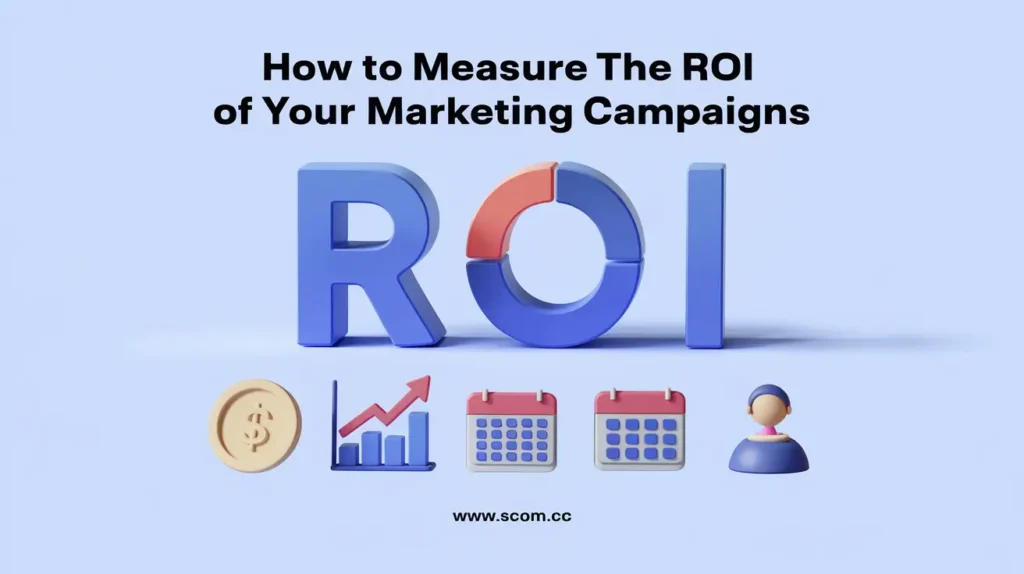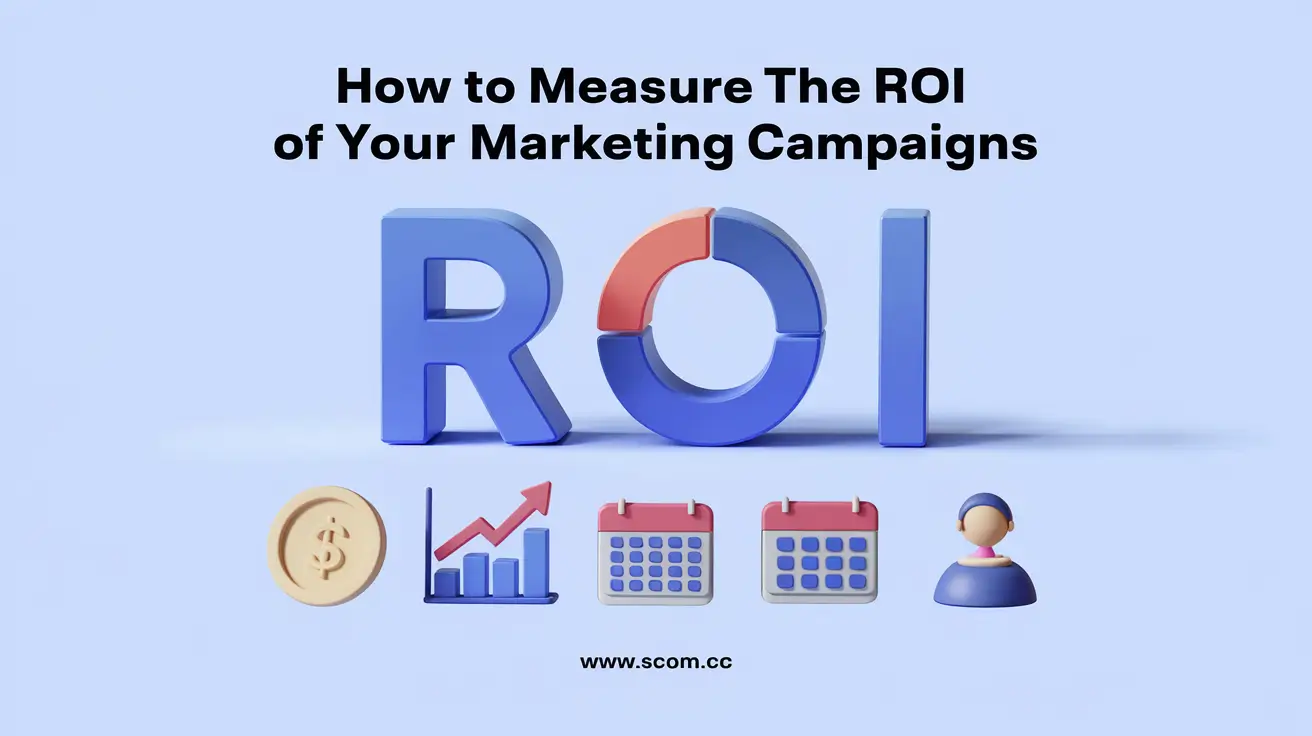How to Measure the ROI of Your Marketing Campaigns

- How to Measure the ROI of Your Marketing Campaigns
- Understanding Marketing ROI
- Setting Clear Objectives and KPIs
- Tracking and Analyzing Data
- Calculating ROI for Different Marketing Channels
- Analyzing the Customer Journey
- Attribution Models and Their Impact
- Evaluating Long-Term vs. Short-Term ROI
- Using ROI Insights to Optimize Campaigns
- Reporting ROI to Stakeholders
- Common Challenges in Measuring Marketing ROI
- Summary Table
-
FAQ
- How can I calculate ROI for my marketing campaigns?
- What are some key KPIs for measuring marketing ROI?
- Which tools can help in tracking marketing ROI?
- How do attribution models impact ROI measurement?
- What challenges might I face when measuring marketing ROI?
- How can I use ROI insights to optimize my marketing campaigns?
- How should I report ROI to stakeholders?
How to Measure the ROI of Your Marketing Campaigns
Measuring the Return on Investment (ROI) of your marketing campaigns is crucial for understanding the effectiveness of your strategies and ensuring that your marketing budget is well-spent. Properly evaluating ROI helps you make informed decisions, optimize future campaigns, and demonstrate the value of marketing efforts to stakeholders. This article delves into the various methods and metrics for measuring marketing ROI, providing actionable insights to maximize your marketing investments.
Understanding Marketing ROI
Marketing ROI is a performance measure used to evaluate the efficiency and profitability of a marketing campaign. It is calculated by comparing the revenue generated from the campaign to the costs associated with it. Understanding this concept is the first step in accurately measuring and interpreting marketing ROI.
Formula for Calculating ROI
The basic formula for calculating ROI is:

Where:
- Net Profit: Total revenue generated from the campaign minus the costs.
- Cost of Investment: Total expenses incurred for the campaign.
For marketing campaigns, net profit is often calculated by subtracting the marketing costs from the revenue directly attributed to the campaign.
Setting Clear Objectives and KPIs
To measure ROI effectively, it’s essential to set clear objectives and Key Performance Indicators (KPIs) for your marketing campaigns. Objectives provide direction and focus, while KPIs help in tracking progress and success.
Steps to Set Objectives and KPIs
- Define Campaign Goals: What do you aim to achieve? Examples include increasing brand awareness, generating leads, or boosting sales.
- Identify Relevant KPIs: Choose KPIs that align with your objectives. Common KPIs include conversion rates, customer acquisition costs, and sales revenue.
- Set Benchmarks: Establish benchmarks to compare performance against past campaigns or industry standards.
Having well-defined objectives and KPIs ensures that you measure the right metrics and gain meaningful insights into your campaign’s performance.
Tracking and Analyzing Data
Accurate data tracking is vital for measuring ROI. Utilize various tools and methods to collect data related to your marketing campaigns. Analyzing this data helps in understanding the effectiveness of your strategies and identifying areas for improvement.
Data Tracking Tools and Techniques
- Google Analytics: Track website traffic, user behavior, and conversion rates.
- CRM Systems: Monitor lead generation, customer interactions, and sales.
- Social Media Analytics: Measure engagement, reach, and performance on social platforms.
- Email Marketing Platforms: Analyze open rates, click-through rates, and conversions.
By leveraging these tools, you can gather comprehensive data to evaluate the success of your campaigns and calculate ROI accurately.
Calculating ROI for Different Marketing Channels
Different marketing channels require different approaches to measuring ROI. Understanding how to calculate ROI for each channel helps in assessing their individual contributions and effectiveness.
Common Marketing Channels and ROI Calculation
- Email Marketing: Calculate ROI by measuring the revenue generated from email campaigns against the cost of email tools and resources.
- Social Media: Measure ROI by analyzing engagement, conversions, and revenue attributed to social media campaigns.
- Content Marketing: Evaluate ROI based on the increase in website traffic, lead generation, and sales resulting from content efforts.
- Paid Advertising: Calculate ROI by comparing the cost of ads to the revenue generated from those ads.
Each channel has its unique metrics and methods for calculating ROI, so tailor your approach accordingly.
Analyzing the Customer Journey
Understanding the customer journey is crucial for measuring ROI accurately. The customer journey encompasses all touchpoints and interactions a customer has with your brand, from awareness to purchase and beyond.
Key Touchpoints to Consider
- Awareness: Initial exposure to your brand through various channels.
- Consideration: Engagement and evaluation of your product or service.
- Decision: Conversion and purchase decision.
- Post-Purchase: Customer satisfaction, retention, and loyalty.
Analyzing how each touchpoint contributes to the overall ROI helps in understanding the effectiveness of your marketing efforts at different stages of the customer journey.
Attribution Models and Their Impact
Attribution models determine how credit for conversions is assigned to various touchpoints in the customer journey. Choosing the right attribution model is essential for accurately measuring ROI and understanding the contribution of each channel.
Common Attribution Models
- First-Click Attribution: Credits the first touchpoint with the entire conversion value.
- Last-Click Attribution: Attributes the entire conversion value to the last touchpoint.
- Linear Attribution: Distributes the conversion value evenly across all touchpoints.
- Time-Decay Attribution: Assigns more value to touchpoints closer to the conversion.
Selecting the appropriate attribution model helps in gaining a clearer picture of how different channels and touchpoints contribute to your campaign’s ROI.
Evaluating Long-Term vs. Short-Term ROI
Marketing campaigns can have both short-term and long-term effects on ROI. Evaluating both perspectives helps in understanding the full impact of your campaigns and making informed decisions for future strategies.
Short-Term ROI
- Immediate Revenue: Measure the direct revenue generated within a short timeframe.
- Quick Metrics: Analyze immediate metrics such as click-through rates, conversions, and lead generation.
Long-Term ROI
- Customer Lifetime Value: Assess the long-term value of customers acquired through the campaign.
- Brand Equity: Evaluate improvements in brand recognition, loyalty, and perception.
Balancing short-term and long-term ROI provides a comprehensive view of your campaign’s effectiveness and overall impact.
Using ROI Insights to Optimize Campaigns
Once you have measured ROI and analyzed the results, use the insights to optimize your marketing campaigns. Continuous improvement based on ROI analysis helps in maximizing the effectiveness of your strategies and achieving better results.
Steps to Optimize Campaigns
- Identify Areas for Improvement: Look for underperforming aspects of your campaigns.
- Adjust Strategies: Modify your tactics based on ROI insights and performance data.
- Test and Iterate: Conduct A/B testing to compare different approaches and refine your strategies.
- Allocate Budget Wisely: Invest more in high-performing channels and reduce spending on less effective ones.
Optimizing your campaigns based on ROI insights ensures that your marketing efforts are continually improving and delivering maximum value.
Reporting ROI to Stakeholders
Effective communication of ROI results to stakeholders is essential for demonstrating the value of marketing efforts and securing support for future initiatives. Prepare clear and concise reports that highlight key metrics and insights.
Components of an Effective ROI Report
- Executive Summary: Provide an overview of campaign performance and ROI.
- Detailed Analysis: Include data and insights on key metrics and KPIs.
- Visualizations: Use charts and graphs to present data clearly.
- Recommendations: Offer actionable recommendations based on the analysis.
A well-prepared ROI report helps in building credibility and showcasing the impact of your marketing campaigns.
Common Challenges in Measuring Marketing ROI
Measuring marketing ROI can come with various challenges. Understanding these challenges helps in overcoming obstacles and ensuring accurate ROI evaluation.
Common Challenges
- Data Integration: Difficulty in combining data from multiple sources.
- Attribution Complexity: Challenges in assigning credit to various touchpoints.
- Long Sales Cycles: Difficulty in measuring ROI for campaigns with extended sales cycles.
- Evolving Metrics: Changes in metrics and KPIs over time.
Addressing these challenges involves using advanced analytics tools, implementing robust data integration strategies, and adapting your measurement approach as needed.
Summary Table
| Aspect | Description | Key Actions |
|---|---|---|
| Understanding Marketing ROI | Evaluating the efficiency and profitability of marketing campaigns. | Use ROI formula: (Net Profit / Cost of Investment) x 100 |
| Setting Clear Objectives and KPIs | Defining goals and metrics to measure campaign success. | Set specific goals, identify relevant KPIs, and establish benchmarks |
| Tracking and Analyzing Data | Collecting and interpreting data related to marketing campaigns. | Use tools like Google Analytics, CRM, social media analytics, and email platforms |
| Calculating ROI for Different Channels | Evaluating ROI for various marketing channels. | Calculate ROI for email marketing, social media, content marketing, and paid ads |
| Analyzing the Customer Journey | Understanding customer interactions from awareness to purchase. | Evaluate touchpoints such as awareness, consideration, decision, and post-purchase |
| Attribution Models and Their Impact | Determining how credit for conversions is assigned. | Choose models like first-click, last-click, linear, or time-decay attribution |
| Evaluating Long-Term vs. Short-Term ROI | Assessing both immediate and long-term effects of campaigns. | Measure short-term revenue and long-term customer value and brand equity |
| Using ROI Insights to Optimize Campaigns | Improving strategies based on ROI analysis. | Identify improvements, adjust strategies, test approaches, and allocate budget effectively |
| Reporting ROI to Stakeholders | Communicating ROI results to stakeholders. | Prepare executive summaries, detailed analyses, visualizations, and recommendations |
| Common Challenges in Measuring ROI | Overcoming obstacles in accurate ROI measurement. | Address data integration issues, attribution complexity, long sales cycles, and evolving metrics |
FAQ
How can I calculate ROI for my marketing campaigns?
To calculate ROI, use the formula:

Net profit is the revenue generated minus the costs, and the cost of investment is the total expenses of the campaign.
What are some key KPIs for measuring marketing ROI?
Key KPIs include conversion rates, customer acquisition costs, sales revenue, and engagement rates. These metrics help in evaluating the effectiveness and profitability of your marketing efforts.
Which tools can help in tracking marketing ROI?
Useful tools for tracking ROI include Google Analytics, CRM systems, social media analytics platforms, and email marketing tools. These tools provide valuable data and insights for accurate ROI measurement.
How do attribution models impact ROI measurement?
Attribution models determine how credit for conversions is assigned to various touchpoints. Models like first-click, last-click, linear, and time-decay affect how ROI is calculated and interpreted.
What challenges might I face when measuring marketing ROI?
Common challenges include data integration difficulties, complexity in attribution, long sales cycles, and evolving metrics. Addressing these challenges involves using advanced analytics tools and adapting measurement approaches.
How can I use ROI insights to optimize my marketing campaigns?
Use ROI insights to identify areas for improvement, adjust strategies, conduct A/B testing, and allocate budget more effectively. Continuous optimization based on ROI helps in maximizing campaign effectiveness.
How should I report ROI to stakeholders?
Prepare clear and concise reports that include an executive summary, detailed analysis, visualizations, and actionable recommendations. Effective reporting demonstrates the value of your marketing efforts and secures support for future initiatives.

If you enjoyed this article and found it valuable, we encourage you to explore our news and valuable information section, where you'll find more relevant and up-to-date content that may pique your interest. Additionally, if you are seeking advice or need guidance on a specific topic, we suggest visiting our services section. There, you will find a variety of options designed to assist and support you in addressing your needs. Feel free to check out both sections to get the information and assistance that best suits your requirements.

Leave a Reply